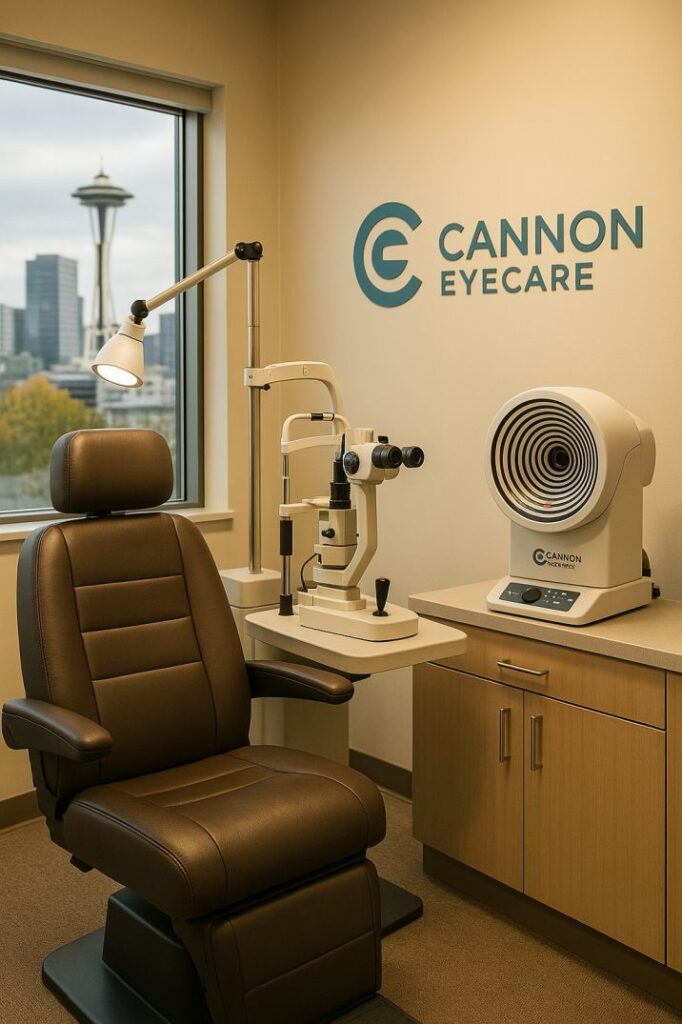Corneal Dystrophies Treatment | Cannon EyeCare Seattle
When your vision becomes cloudy or you experience persistent eye discomfort, it might be more than just aging—it could be corneal dystrophies. At Cannon EyeCare, serving the Seattle area with locations at University Village and Pike Place Market, we combine Midwestern hospitality with cutting-edge expertise to diagnose and treat these complex genetic eye conditions. This comprehensive guide will help you understand corneal dystrophies, recognize symptoms, and discover the advanced treatment options available at Cannon EyeCare in Seattle.
What Are Corneal Dystrophies?
Corneal dystrophies are a group of rare, inherited eye disorders affecting the cornea—the clear, dome-shaped front layer of your eye that helps focus light. These genetic conditions cause abnormal material to accumulate in different layers of the cornea, gradually affecting its transparency and your vision quality.
Unlike other eye conditions that develop due to injury or environmental factors, corneal dystrophies are present from birth but often don’t show symptoms until later in life. They typically affect both eyes symmetrically and progress slowly over the years or even decades. The International Classification of Corneal Dystrophies (IC3D) recognizes over 20 distinct types, each with unique characteristics and treatment approaches.
The Structure of Your Cornea
To understand corneal dystrophies, it’s helpful to know that your cornea consists of five distinct layers:
- Epithelium: The outermost protective layer
- Bowman’s membrane: A thin protective barrier
- Stroma: The thick middle layer (90% of corneal thickness)
- Descemet’s membrane: A thin basement membrane
- Endothelium: The innermost layer that pumps fluid out
Different types of corneal dystrophies affect different layers, which determines their symptoms and treatment approaches.
Types of Corneal Dystrophies: Understanding the Four Main Categories
Epithelial and Subepithelial Dystrophies
These dystrophies affect the outer layers of your cornea and often cause painful corneal erosions—episodes where the surface layer doesn’t adhere properly.
Epithelial Basement Membrane Dystrophy (Map-Dot-Fingerprint Dystrophy)
- Most common epithelial dystrophy
- Typically affects adults aged 40-70
- Causes irregular maps, dots, or fingerprint-like patterns on the cornea
- May cause sudden eye pain, especially upon waking
- Often manageable with lubricating drops and specialized contact lenses
Meesmann Dystrophy
- Appears as tiny cysts in the epithelium
- Usually begins in childhood, but symptoms may not appear until adulthood
- Generally causes mild irritation and slight vision changes
- Treated primarily with lubricating eye drops
Epithelial-Stromal TGFBI Dystrophies
These dystrophies are caused by mutations in the TGFBI gene and involve both the epithelium and stromal layers.
Reis-Bücklers Dystrophy
- Appears early in life with recurrent corneal erosions
- Causes honeycomb-like opacity in Bowman’s layer
- May require specialized treatments or surgery as it progresses
Thiel-Behnke Dystrophy
- Similar to Reis-Bücklers but with distinct patterns
- Often causes significant visual impairment over time
- May benefit from phototherapeutic keratectomy (PTK)
Stromal Dystrophies
These affect the thick middle layer of the cornea and often cause characteristic patterns visible during examination.
Granular Corneal Dystrophy
- Causes crumb-like opacities in the central cornea
- Usually begins in childhood but may not affect vision until later
- Two main types: Granular Type 1 (Groenouw Type 1) and Granular Type 2 (Avellino)
- Advanced cases may require corneal transplantation
Lattice Corneal Dystrophy
- Creates glass-like filamentous lines in the cornea resembling a lattice pattern
- Usually begins before age 20
- Can cause recurrent corneal erosions and progressive vision loss
- Two main types with different genetic causes and presentations
- Causes cloudy patches throughout the cornea
- Often begins in the first decade of life
- Generally has a more severe course than other stromal dystrophies
- May require corneal transplantation earlier than other types
Endothelial Dystrophies
These affect the innermost layer responsible for keeping the cornea clear by pumping out excess fluid.
Fuchs’ Endothelial Corneal Dystrophy (FECD)
- **Most common corneal dystrophy requiring treatment
- Affects approximately 4% of Americans over age 40
- More common in women (about 3 times more likely than men)
- Causes corneal swelling, morning vision cloudiness, and eventual corneal edema
Posterior Polymorphous Dystrophy
- Causes abnormal cell growth on the corneal endothelium
- Often asymptomatic, but can progress to require treatment
- May be associated with other eye abnormalities
Recognizing the Symptoms of Corneal Dystrophies
The symptoms of corneal dystrophies vary significantly depending on the type and severity. Many people live with mild dystrophies without ever knowing they have them, while others experience progressive vision problems that significantly impact their quality of life.
Common Early Symptoms
- Blurred or hazy vision: Particularly noticeable in the morning
- Light sensitivity (photophobia): Bright lights become uncomfortable
- Foreign body sensation: Feeling like something is in your eye
- Excessive tearing: Your eyes may water more than usual
- Eye pain or discomfort: Often worse upon waking
Progressive Symptoms
As corneal dystrophies advance, you may experience:
- Worsening vision: Objects may appear cloudy or distorted
- Corneal erosions: Sudden, severe eye pain, often in the morning
- Difficulty with night vision: Halos or starbursts around lights
- Contact lens intolerance: Previously comfortable lenses become irritating
Morning Pain: A Telltale Sign
One characteristic symptom of many corneal dystrophies is eye pain that’s worse in the morning and improves throughout the day. This occurs because your eyes produce fewer tears while sleeping, allowing the corneal surface to dry out and potentially separate from underlying layers.
Advanced Diagnostic Techniques at Cannon EyeCare
At Cannon EyeCare, we use state-of-the-art diagnostic technology to accurately identify and monitor corneal dystrophies. Our comprehensive approach ensures early detection and precise treatment planning.
Slit Lamp Examination
Our high-magnification slit lamp microscopes allow us to examine your cornea in detail, identifying characteristic patterns and deposits that indicate specific dystrophies. This painless examination provides immediate visual information about your corneal health.
Corneal Topography and Tomography
Advanced imaging technology maps the shape and thickness of your cornea, revealing subtle irregularities that may not be visible during routine examination. This technology is particularly valuable for monitoring progression and planning treatments.
Pachymetry
We measure corneal thickness using ultrasonic or optical pachymetry, which is essential for diagnosing conditions like Fuchs’ dystrophy, where corneal swelling is a key feature.
Specular Microscopy
This specialized imaging technique photographs the corneal endothelium, allowing us to count and evaluate the health of the cells responsible for keeping your cornea clear. This is particularly important for diagnosing and monitoring endothelial dystrophies.
Genetic Testing
For confirmed cases or family members at risk, genetic testing can identify specific mutations associated with corneal dystrophies. This information helps with family planning and provides valuable prognostic information.
Comprehensive Treatment Options: From Conservative to Cutting-Edge
Treatment for corneal dystrophies depends on the type, severity, and how much your vision and comfort are affected. At Cannon EyeCare, we offer the full spectrum of treatment options, always starting with the most conservative approaches.
Conservative Management
Lubricating Eye Drops and Ointments
- Artificial tears help maintain corneal surface health
- Preservative-free formulations reduce irritation
- Thicker ointments provide longer-lasting protection, especially overnight
Specialized Contact Lenses
- Bandage contact lenses protect the corneal surface from erosions
- Therapeutic lenses can improve comfort and vision
- Gas-permeable lenses may help with irregular astigmatism
Environmental Modifications
- Humidifiers maintain moisture in dry environments
- Protective eyewear shields the eyes from wind and debris
- Sleep positioning adjustments may reduce morning symptoms
Advanced Non-Surgical Treatments
Hyperosmotic Agents
- Concentrated salt solutions help reduce corneal swelling
- Available as drops or ointments for daily use
- Particularly effective for endothelial dystrophies
Punctal Plugs
- Tiny devices that block tear drainage to keep eyes moist
- Reversible option for managing dry eye symptoms
- Can significantly improve comfort in dystrophy patients
Surgical Interventions
When conservative treatments aren’t sufficient, various surgical options can restore vision and comfort.
Phototherapeutic Keratectomy (PTK)
- Laser treatment that removes superficial corneal irregularities
- Particularly effective for epithelial and anterior stromal dystrophies
- Outpatient procedure with relatively quick recovery
- May need to be repeated as dystrophy progresses
Endothelial Keratoplasty
- Advanced partial corneal transplant techniques
- DMEK (Descemet Membrane Endothelial Keratoplasty) and DSAEK (Descemet Stripping Automated Endothelial Keratoplasty)
- Faster recovery than full-thickness transplants
- Excellent outcomes for endothelial dystrophies
Penetrating Keratoplasty (Full-Thickness Corneal Transplant)
- Complete replacement of the central cornea
- Reserved for advanced cases with multiple-layer involvement
- Longest recovery time, but can restore vision dramatically
- Success rates exceed 90% in most cases
Emerging Therapies: The Future of Corneal Dystrophy Treatment
The field of corneal dystrophy treatment is rapidly evolving, with several promising therapies on the horizon.
Gene Therapy
Researchers are developing gene-based treatments that could address the underlying genetic causes of corneal dystrophies. Recent studies have shown promise for CRISPR-Cas9 gene editing in treating Fuchs’ dystrophy and TGFBI-related dystrophies. While still in clinical trials, these treatments could potentially prevent or reverse dystrophy progression.
Cell Therapy
Innovative treatments using cultivated corneal cells are showing remarkable promise. Companies like Aurion Biotech and Emmecell are conducting clinical trials for injectable endothelial cell therapies that could treat Fuchs’ dystrophy without surgery. These treatments, expected to become available in the next few years, could revolutionize care for endothelial dystrophies.
Regenerative Medicine
Researchers are exploring the use of stem cells and tissue engineering to regenerate healthy corneal tissue. These approaches could provide alternatives to traditional transplantation, potentially eliminating the need for donor tissue and reducing rejection risk.
Living with Corneal Dystrophies: Practical Strategies for Daily Life
While corneal dystrophies can be challenging, many patients lead full, active lives with proper management and care.
Managing Daily Activities
- Use proper lighting: Bright, even lighting reduces strain and improves vision.n
- Protect your eyes: Wraparound sunglasses shield from wind and UV rays
- Stay hydrated: Proper hydration supports overall eye health
- Follow medication schedules: Consistent use of prescribed drops is crucial
Workplace Considerations
- Computer work: Use the 20-20-20 rule (look at something 20 feet away for 20 seconds every 20 minutes)
- Environmental controls: Request humidity adjustments or positioning away from air vents
- Lighting adjustments: Anti-glare screens and adjustable lighting can help
Family Planning and Genetic Counseling
Since corneal dystrophies are inherited conditions, genetic counseling can provide valuable information for family planning. Understanding inheritance patterns helps families make informed decisions and ensures appropriate screening for at-risk family members.
The Cannon EyeCare Advantage: Why Choose Us for Your Corneal Care
At Cannon EyeCare, we understand that dealing with corneal dystrophies can feel overwhelming. That’s why we combine the warmth and unhurried attention of Midwestern hospitality with the expertise and technology of a premier eye care practice specializing in corneal dystrophies.
Our Comprehensive Approach to Corneal Dystrophies
- Thorough examinations: We take the time needed to properly evaluate your corneal dystrophies
- Advanced technology: State-of-the-art diagnostic equipment for precise evaluation of corneal dystrophies
- Personalized treatment plans: Every patient receives individualized care for their specific type of corneal dystrophy
- Ongoing monitoring: Regular follow-ups to track progression and adjust treatments
Convenient Seattle Locations for Corneal Dystrophies Treatment
Our University Village and Pike Place Market locations make quality corneal dystrophy care accessible throughout the Seattle area. Both Cannon EyeCare locations offer:
- Easy parking: No need to worry about finding a spot
- Modern facilities: Clean, comfortable environments with the latest equipment
- Flexible scheduling: Appointments that work with your busy life
- Insurance acceptance: We work with most major insurance plans
Building Long-Term Relationships for Corneal Dystrophies Care
Corneal dystrophies are chronic conditions that benefit from consistent, long-term care. Cannon EyeCare is committed to being your partner in maintaining your vision and eye health for years to come. Our approach to corneal dystrophies focuses on:
- Education: Helping you understand your corneal dystrophies and treatment options
- Support: Providing ongoing guidance and answering your questions about corneal dystrophies
- Innovation: Staying current with the latest corneal dystrophies treatments and technologies
- Coordination: Working with other specialists when corneal dystrophies care requires additional expertise
Recent Research and Scientific Advances
The field of corneal dystrophy research is more active than ever, with significant breakthroughs improving our understanding and treatment options.
Key Research Findings
Recent studies have provided important insights into corneal dystrophies:
-
Prevalence Data: Current research shows that corneal dystrophies affect approximately 897 per million people in the United States, with significant variations by age, gender, and ethnicity.
-
Genetic Understanding: Researchers have identified multiple genetic mutations associated with various corneal dystrophies, improving diagnostic accuracy and enabling genetic testing.
-
FECD Prevalence: Studies confirm that Fuchs’ endothelial corneal dystrophy affects about 4% of Americans over age 40, with women being three times more likely to develop the condition than men.
Clinical Trials and Future Treatments
Several promising treatments are currently in clinical trials:
- EO2002 Injectable Cell Therapy: Phase 3 trials are expected to be completed in 2025 for this magnetic cell therapy for Fuchs’ dystrophy, with potential FDA approval by 2026-2027
- Gene Editing Approaches: CRISPR-Cas9 trials are showing promise for correcting genetic defects in various corneal dystrophies
- Regenerative Therapies: Stem cell treatments are being developed to regenerate healthy corneal tissue
- Cultured Cell Injections: Clinical trials are underway for injecting healthy donor corneal endothelial cells to avoid traditional transplantation
Schedule Your Comprehensive Corneal Dystrophies Examination Today
If you’re experiencing any symptoms that might indicate corneal dystrophies, or if you have a family history of these conditions, don’t wait to seek expert evaluation. Early detection and proper management of corneal dystrophies can make a significant difference in preserving your vision and comfort.
At Cannon EyeCare, we’re committed to providing the highest quality care for corneal dystrophies and all your eye health needs. Our experienced team combines advanced diagnostic technology with personalized attention to ensure you receive the best possible corneal dystrophies care.
Contact Cannon EyeCare for Corneal Dystrophies Treatment
University Village Location
- Convenient parking and easy access for corneal dystrophy patients
- State-of-the-art diagnostic equipment for corneal dystrophies evaluation
- Comprehensive corneal dystrophy evaluations by experienced specialists
- Central Seattle location for corneal dystrophies care
- Full-service eye care, including corneal dystrophies treatment
- Specialist consultations available for complex corneal dystrophy cases
What to Expect at Your Corneal Dystrophies Visit
During your comprehensive corneal dystrophies examination at Cannon EyeCare, we’ll:
- Review your symptoms and family history of corneal dystrophies
- Perform detailed corneal imaging and analysis to diagnose corneal dystrophies
- Discuss your corneal dystrophies diagnosis and treatment options
- Develop a personalized care plan for your specific type of corneal dystrophy
- Schedule appropriate follow-up care for ongoing corneal dystrophies management
Remember, corneal dystrophies are manageable conditions, and with proper care at Cannon EyeCare, most patients maintain good vision and comfort throughout their lives. Don’t let uncertainty about your eye health affect your quality of life—schedule your corneal dystrophies examination today and take the first step toward clearer, more comfortable vision.
FAQs
-
Corneal dystrophies are rare, inherited eye disorders causing abnormal material to build up in the cornea, leading to cloudy or blurred vision over time




